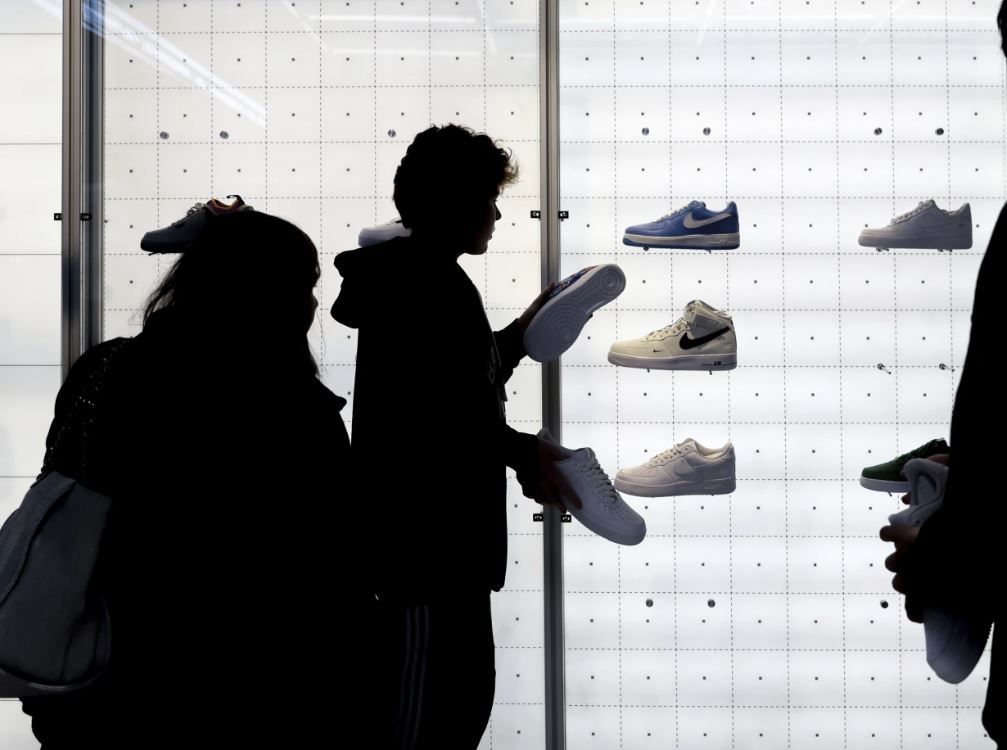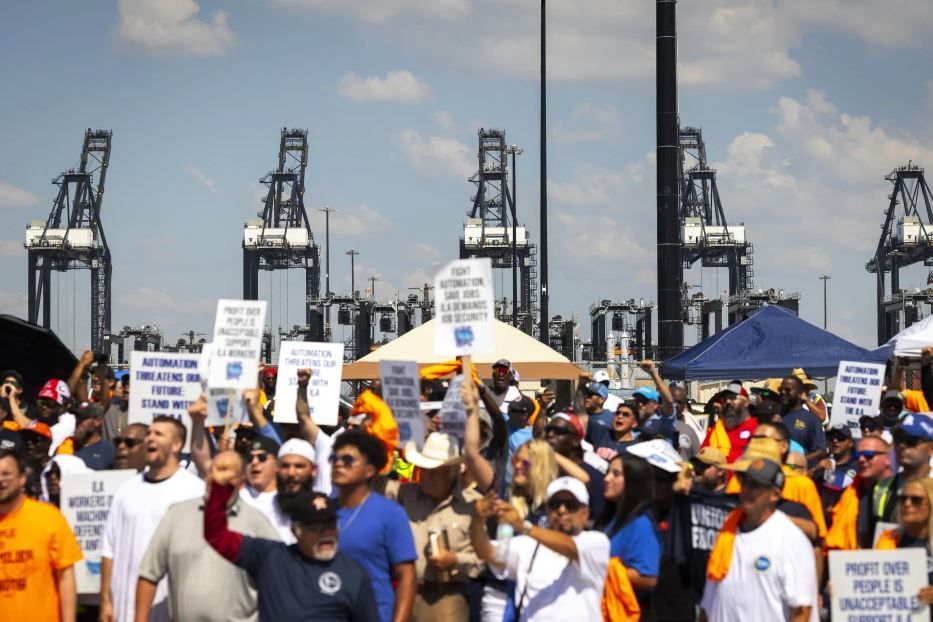More Americans are expected to ‘buy now, pay later’ for the holidays. Analysts see a growing risk
- By 6122ee467d22433199917c7d
- •
- 14 Dec, 2023
More Americans are expected to ‘buy now, pay later’ for the holidays. Analysts see a growing risk

Consumers are expected to use “buy now, pay later” payment plans heavily this holiday season, a forecast that bodes well for retailers but that has credit experts again sounding alarm bells.
The short-term loans often come with consumer-friendly interest rates and allow shoppers to make an initial payment at checkout, then pay the rest in installments, typically over a few weeks, even months. That can be appealing to a shopper buying multiple gifts for family and friends during the holidays, particularly if they’re balancing other debt such as student loans or credit cards.
Data shows younger consumers and those with difficulty accessing credit use the loans most frequently. Used responsibly, the installment plans increase financial inclusion, according to the Federal Reserve Bank of New York. But the Fed and some analysts say key features of the plans can make borrowing too easy and saddle consumers with excessive debt.
Short-term installment loans drove $6.4 billion of online spending in October, up 6% year over year, according to a recent Adobe Analytics report on online shopping. Adobe expects usage to peak in November with spending of $9.3 billion, including a single-day record of $782 million on Cyber Monday. Overall, Adobe estimates one in five Americans plan to use buy now, pay later plans to purchase holiday gifts.
Vivek Pandya, lead analyst for Adobe Digital Insights, said that “rising interest rates, inflation in food prices, and resuming student loan repayments” have increased costs for consumers, but “data has shown that the consumer remains resilient heading into the big holiday season and (they) are embracing every opportunity to manage their budgets in more efficient ways.”
‘Buy now, pay later’ loans tend to follow a shared model. The lender runs a soft credit check on applicants, then asks for a down payment at the time of purchase along with an agreement to make between four and six payments at two-week intervals, though terms vary. Zero-interest loans are common initial offerings.
If a customer pays late or misses payments, however, they can be shut out from using the app, or face interest or fees. Sometimes these are flat amounts, as much as $25, and sometimes they’re calculated as a percentage of the outstanding loan.
Pay-in-installment companies collect fees from merchants who are grateful for the increased business. Retailers have found that customers offered a buy now, pay later option are more likely to have bigger cart sizes or to convert from browsing to checking out. In its report, the Fed cites research that finds that customers spend 20% more when buy now, pay later is available.
Most of these short-term loans are not reported to the three main credit bureaus. Consumers appreciate that because the loans don’t affect their credit scores. But this is the feature of buy now, pay later that worries experts the most because it can lead to “loan-stacking” -- when consumers take on debt with multiple lenders.
Demishia Alford, 26, of Greensboro, North Carolina said she uses the short-term loans for household goods, clothes, and plane tickets. For the holidays, she plans to use the loans to buy a new crate for her puppy, electronics, and other gifts for her in-laws, nieces, and nephews. She said the retailers she patronizes include Express, Shein, and Walmart.
According to Alford, her short-term loans average about $200 or less and help her walk a financial tightrope of sorts. She’s paying down student loans, a car loan, and several thousand dollars of credit card debt. Both her credit cards are nearly maxed out.
“I try to stay on top of it, especially in today’s economy,” she said. “Debt creeps up on you.”
Asked whether she thinks she’ll continue to use installment plans, Alford said, “Hopefully not. Hopefully I’ll be in a place where I don’t have to break up payments, and I’m not working on a budget soon.”
Kevin King, vice president of credit risk at LexisNexis Risk Solutions said that because pay-in-installment loans often go unreported to credit bureaus, and the companies don’t report to one another, lenders face an underwriting challenge. The opacity of the space, combined with the increasing number of companies offering the loans, compounds risk.
“Right now, it’s really tough for BNPL lenders to know that Kevin may have taken out a loan from four other BNPL lenders earlier this week,” he said. “That can let consumers trap themselves in debt.”
Alford — whose use of buy now, pay later loans at multiple companies is not reported to the credit bureaus, potentially masking her credit-worthiness -- is an example of the type of borrower that King worries about.
LexisNexis Risk Solutions provides many buy now, pay later lenders with alternative credit scores for assessing consumers seeking loans, including those who may not have a traditional credit score. In new research, the company found that pay-in-installment loans attract more non-prime (including subprime and near prime) credit applicants than traditional banking products and that the users are more than twice as likely to be under 35.
Jessica Sarceda, 28, of Santa Monica, California, said she’ll be using installment loans with four payments for her holiday shopping this year - mostly gifts of shoes and clothes for family and friends. She said she decided to use Zip, another company that provides short-term loans, after using the app to update her wardrobe each season. She prefers spreading out the payments to using a credit card.
“I wouldn’t say I use it for large expenses,” Sarceda said. “Payments are hundreds of dollars, not thousands. And it’s usually event-based. If there’s a music festival, or a wedding - that’s typically where I’ll use Zip.”
Starting again last month, after a pandemic-linked pause, Sarceda has also begun paying down her student loan.
For the holidays, Allison Williams, 28, in Amelia, Ohio, said she’ll be using pay-in-four loans to get her two-year-old daughter a swing set for the yard. She also plans to buy Nike merchandise for her six brothers and sisters. In the past two years, Williams has used buy now, pay later plans at stores including Target, BoxLunch, EyeBuyDirect, and Skims. She typically uses multiple lenders — Klarna, AfterPay, Sezzle, and PayPal’s Pay in 4 — for larger purchases, she said, especially when buying many items from the same retailer.
Though Williams has a credit card, she says she uses it “for things like gas and groceries to make sure I’m keeping up with my credit. If I have extra money, I just pay off (the pay-in-four loans) early.”
Jinal Shah, Chief Marketing Officer for Zip, said pay-in-four lenders are able to see quickly when borrowers are missing or unable to make payments, as happened a year and a half ago, when inflation first took a toll, and the companies adjust their underwriting accordingly, including by removing users from the platform.
“Since payments are in two-week increments, it gives us an opportunity to be ahead of the pulse,” she said. “It has more built-in signals to help us manage than with credit cards.”
Savannah Britt owes about $27,000 on loans she took out to attend college at Rutgers University, a debt she was hoping to see reduced by President Joe Biden’s student loan forgiveness efforts.
Her payments are currently on hold while courts untangle challenges to the loan forgiveness program. But as the weeks tick down on Biden’s time in office, she could soon face a monthly payment of up to $250.
“With this new administration , the dream is gone. It’s shot,” said Britt, 30, who runs her own communications agency. “I was hopeful before Tuesday. I was waiting out the process. Even my mom has a loan that she took out to support me. She owes about $18,000, and she was in the process of it being forgiven, but it’s at a standstill.”
President-elect Donald Trump
and his fellow Republicans have criticized Biden’s loan forgiveness efforts, and lawsuits by GOP-led states have held up plans for widespread debt cancellation. Trump has not said what he would do on loan forgiveness, leaving millions of borrowers facing uncertainty over their personal finances.
The economy
was an important issue in the election, helping to propel Trump to victory. But for borrowers, concerns about their finances extend beyond inflation to include their student debt, said Persis Yu, managing counsel for the Student Borrower Protection Center.
“That’s a big part of what is making life unaffordable for them is this burden of expenses that they can’t seem to get out from under,” Yu said.
Student loan cancellation was not a focus of the campaign for either Trump or Vice President Kamala Harris , who steered clear of the issue at her political events. The issue came up just once in the September presidential debate, when Trump hammered Harris and Biden for failing to deliver their promise of widespread forgiveness. Trump called it a “total catastrophe” that “taunted young people.”
Biden promised the student loan cancellation program during his run for the presidency. From its launch, Biden’s loan forgiveness faced relentless pushback from opponents who said it heaped advantage on elites and came at the expense of those who repaid their loans or did not attend college.
Biden’s first plan to cancel up to $20,000 for millions of people was blocked by the Supreme Court last year. A second, narrower plan has been halted by a federal judge after Republican-led states sued. A separate policy intended to lower loan payments for struggling borrowers has been paused by a judge, also after Republican-controlled states challenged it.
Overall, Biden’s efforts were relatively unpopular, even among those with student loans. Three in 10 U.S. adults said they approved of how Biden had handled student loan debt, according to a poll this spring from the University of Chicago Harris School of Public Policy and The Associated Press-NORC Center for Public Affairs Research . Four in 10 disapproved. The others were neutral or didn’t know enough to say.
Project 2025, the blueprint for a hard-right turn in American government that aligns with some Trump priorities , calls for getting the federal government out of the student loan business and doing away with repayment plans that pre-date the Biden administration.
Even without directly addressing student loans, Trump has made promises that would affect them. He has pledged to eliminate the U.S. Department of Education, which manages the $1.6 trillion federal student loan portfolio. It’s unclear which entity would take that responsibility if the department were eliminated, which would require approval from Congress.Yu noted the Biden administration managed to cancel student loans for about 5 million borrowers , even though the signature forgiveness effort has been blocked. The administration did it by leaning into loan cancellation programs already in effect. For example, an existing student loan forgiveness program for public service workers has granted relief to more than 1 million Americans, up from just 7,000 who were approved before it was updated by the Biden administration two years ago.
“A lot of the cancellation that we saw in the last couple of years was because the Biden administration was committed to making the programs that are actually enshrined in law work for people,” Yu said.
The challenge of repaying the $23,000 she has borrowed to study education policy at Columbia University weighs on 23-year-old Zaakirah Rahman, but she said she did not see an alternative to pursing an advanced degree.
“It feels like the threshold for things is getting higher and suddenly getting a bachelor’s degree isn’t enough,” she said. “It’s expensive. It’s super expensive. But it seems like you don’t really have a choice.”
Sabrina Calazans, 27, owes about $30,000 on federal student loans from her college days at Arcadia University in Pennsylvania. Her payments also have been on hold, but she could soon face a monthly payment of over $300.
“As a first-generation American, I live at home with my family, I contribute to our household finances, and that payment is a lot for me and so many others like me,” said Calazans, who is originally from Brazil.
In her role as managing director for Student Debt Crisis Center, Calazans said she has been telling people to stay up to date on developments by using the loan simulator on the Federal Student Aid website and reading updated information on forgiveness qualifications and repayment programs.
“There’s a lot of confusion about student loans,” Calazans said, and not just among young people. “We’re seeing a lot of parents take out more debt for their children to be able to go to school. We’re seeing older folks go back to school and having to take out loans as well.”
SOURCE: AP NEWS

U.S. stocks are rallying Tuesday as voters head to the polls on the last day of the presidential election and as more data piles up showing the economy remains solid.
The S&P 500 was up 1.2% in afternoon trading, rising closer to its record set last month . The Dow Jones Industrial Average was up 431 points, or 1%, as of 12:50 p.m. Eastern time, while the Nasdaq composite was 1.5% higher.
Treasury yields also rallied after a report showed growth for retailers, transportation companies and other businesses in the U.S. services industries accelerated last month. That was despite economists’ expectations for a slowdown, and the Institute for Supply Management said it was the strongest growth since July 2022.
The strong data offered more hope that the U.S. economy will remain solid
and avoid a long-feared recession
following the worst inflation in generations
.
Excitement about the artificial-intelligence boom also helped lift the stock market, as it has for much of the last year. Software company Palantir Technologies jumped 23% after delivering bigger profit and revenue than analysts expected for the latest quarter. It’s an industry known for thinking and talking big, and CEO Alexander Karp said, “We absolutely eviscerated this quarter, driven by unrelenting AI demand that won’t slow down.”
It helped offset a 6.3% drop for NXP Semiconductors. The Dutch company fell to one of the largest losses in the S&P 500 after warning that weakness it saw in the industrial and other markets during the latest quarter is spreading to Europe and the Americas.
The market’s main event, though, is the election, even if the result may not be known for days, weeks or months as officials count all the votes. Such uncertainty could upset markets, along with an upcoming meeting by the Federal Reserve on interest rates later this week. The widespread expectation is for it to cut its main interest rate for a second straight time, as it widens its focus to keeping the job market solid in addition to getting inflation under control.
Despite all the uncertainty heading into the final day of voting, many professional investors suggest keeping the focus on the long term and what corporate profits will do over the next few years and a decade. The broad U.S. stock market has historically tended to rise regardless of which party wins the White House, even if each party’s policies help and hurt different industries’ profits underneath the surface.
Since 1945, the S&P 500 has risen in 73% of the years where a Democrat was president and 70% of the years when a Republican was the nation’s chief executive, according to Sam Stovall, chief investment strategist at CFRA.
The U.S. stock market has tended to rise more in magnitude when Democrats have been president, in part because a loss under George W. Bush’s term hurt the Republican’s average. Bush took over as the dot-com bubble was deflating and exited office when the 2008 global financial crisis and Great Recession were devastating markets.
The S&P 500 ended up rising 69.6% from that Election Day in 2020 through Monday, following President Joe Biden’s win. It set its latest all-time high on Oct. 18, as the U.S. economy bounced back from the COVID-19 pandemic and managed to avoid a recession despite a jump in inflation.
In the prior four years, the S&P 500 rose 57.5% from Election Day 2016 through Election Day 2020, in part because of cuts to tax rates signed by Trump.
Investors have already made moves in anticipation of a win by either Trump or Vice President Kamala Harris. The value of the Mexican peso might fall if Trump’s tariffs on Mexico come to fruition, for example.
But Paul Christopher, head of global investment strategy at Wells Fargo Investment Institute, suggests not getting caught up in the pre-election moves, or even those immediately after the polls close, “which we believe will face inevitable tempering, if not outright reversals, either before or after Inauguration Day.”
In the bond market, the yield on the 10-year Treasury rose to 4.34% following Tuesday morning’s strong report on U.S services businesses from 4.29% late Monday.
In stock markets abroad, indexes were mixed in Europe and Asia. The moves were mostly modest outside of jumps of 2.3% in Shanghai and 2.1% in Hong Kong.

Some manufacturers and retailers are urging President Joe Biden to invoke a 1947 law as a way to suspend a strike by 45,000 dockworkers that has shut down 36 U.S. ports from Maine to Texas.
At issue is Section 206 of the Labor Management Relations Act of 1947, better known as the Taft-Hartley Act. The law authorizes a president to seek a court order for an 80-day cooling-off period for companies and unions to try to resolve their differences.
Biden has said, though, that he won’t intervene in the strike.
Taft-Hartley was meant to curb the power of unions
The law was introduced by two Republicans — Sen. Robert Taft of Ohio and Rep. Fred Hartley Jr. of New Jersey — in the aftermath of World War II. It followed a series of strikes in 1945 and 1946 by workers who demanded better pay and working conditions after the privations of wartime.
President Harry Truman opposed Taft-Hartley, but his veto was overridden by Congress.
In addition to authorizing a president to intervene in strikes, the law banned “closed shops,” which require employers to hire only union workers. The ban allowed workers to refuse to join a union.
Taft-Hartley also barred “secondary boycotts,’' thereby making it illegal for unions to pressure neutral companies to stop doing business with an employer that was targeted in a strike.
It also required union leaders to sign affidavits declaring that they did not support the Communist Party.
Presidents can target a strike that may “imperil the national health and safety”
The president can appoint a board of inquiry to review and write a report on the labor dispute — and then direct the attorney general to ask a federal court to suspend a strike by workers or a lockout by management.
If the court issues an injunction, an 80-day cooling-off period would begin. During this period, management and unions must ”make every effort to adjust and settle their differences.’'
Still, the law cannot actually force union members to accept a contract offer.
Presidents have invoked Taft-Hartley 37 times in labor disputes
According to the Congressional Research Service, about half the time that presidents have invoked Section 206 of Taft-Hartley, the parties worked out their differences. But nine times, according to the research service, the workers went ahead with a strike.
President George W. Bush invoked Taft-Hartley in 2002 after 29 West Coast ports locked out members of the International Longshore and Warehouse Union in a standoff. (The two sides ended up reaching a contract.)
Biden has said he won’t use Taft-Hartley to intervene
Despite lobbying by the National Association of Manufacturers and the National Retail Federation, the president has maintained that he has no plans to try to suspend the dockworkers’ strike against ports on the East and Gulf coasts.
On Wednesday, before leaving Joint Base Andrews for an air tour of North Carolina to see the devastation from Hurricane Helene, Biden said the port strike was hampering efforts to provide emergency items for the relief effort.
“This natural disaster is incredibly consequential,” the president said. “The last thing we need on top of that is a man-made disaster — what’s going on at the ports.”
Biden noted that the companies that control East and Gulf coast ports have made huge profits since the pandemic.
“It’s time for them to sit at the table and get this strike done,” he said.
Though many ports are publicly owned, private companies often run operations that load and unload cargo.
William Brucher, a labor relations expert at Rutgers University, notes that Taft-Hartley injunctions are “widely despised, if not universally despised, by labor unions in the United States.”
And Vice President Kamala Harris is relying on support from organized labor in her presidential campaign against Donald Trump.
If the longshoremen’s strike drags on long enough and causes shortages that antagonize American consumers, pressure could grow on Biden to change course and intervene. But experts like Brucher suggest that most voters have already made up their minds and that the election outcome is “really more about turnout” now.
Which means, Brucher said, that “Democrats really can’t afford to alienate organized labor.”

